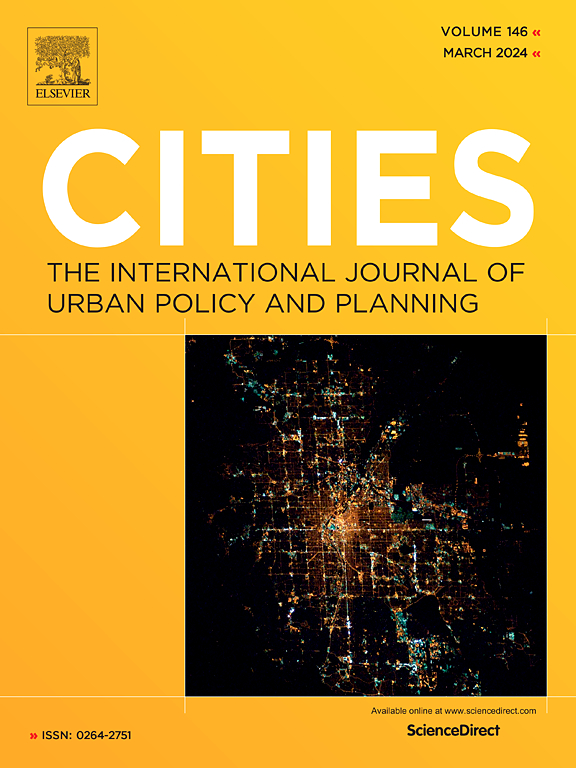How responsible are land acquisitions for megaprojects in global south cities?
IF 6.6
1区 经济学
Q1 URBAN STUDIES
引用次数: 0
Abstract
The pursuit of modernisation and development has significantly fuelled the proliferation of megaprojects in the Global South over the past decade. While these projects are often initiated to address pressing societal challenges, the impacts on affected communities are frequently overlooked during the planning phase. Although substantial research has explored the scope, outcomes, and failures of megaprojects globally, limited attention has been given to the land acquisition process—arguably the most critical and complex stage. This study examines the land acquisition process for the Ibadan Circular Road Project (ICRP), the largest infrastructure investment in Oyo State, Nigeria, in the past 50 years. Two diagnostic frameworks are employed: the Responsible Land Management (RLM) framework and the Risks and Reconstruction Model (RRM). The RLM framework is used to assess the extent to which the ICRP aligns with principles of responsible land management, while the RRM is applied to identify risks (i.e., manifestations of irresponsibility) associated with displacement. A qualitative research design was adopted, involving interviews with affected residents and planning practitioners. Media content—sourced from online newspapers and television reports—was also leveraged and analysed thematically. Findings indicate that the land acquisition process for the ICRP fails to meet most of the responsibility criteria outlined in the RLM framework. While the project seeks to alleviate traffic congestion in Ibadan—thus meeting the responsiveness criterion—it lacks key elements such as resilience, robustness, reliability, reflexivity, retraceability, and respect for affected communities. Unlike many other megaprojects, the displacement associated with the ICRP has resulted in the realisation of all risks predicted by the RRM model, including landlessness, homelessness, marginalisation, among others. The study discusses the nuances of these irresponsibilities and offers practical recommendations to improve land acquisition practices in future megaprojects, particularly within the context of urban development in the Global South.
全球南方城市大型项目的土地征用是否负责任?
在过去十年中,对现代化和发展的追求极大地推动了全球南方国家大型项目的激增。虽然这些项目通常是为了解决紧迫的社会挑战而启动的,但在规划阶段往往忽视了对受影响社区的影响。尽管大量的研究探索了全球大型项目的范围、结果和失败,但对土地征用过程的关注有限——可以说是最关键和最复杂的阶段。本研究考察了伊巴丹环城公路项目(ICRP)的征地过程,该项目是尼日利亚奥约州过去50年来最大的基础设施投资。采用了两个诊断框架:负责任土地管理(RLM)框架和风险与重建模型(RRM)。RRM框架用于评估ICRP与负责任土地管理原则的一致程度,而RRM用于识别与流离失所相关的风险(即不负责任的表现)。采用质性研究设计,对受影响的居民和规划从业人员进行访谈。来自在线报纸和电视报道的媒体内容也被利用并进行了主题分析。调查结果表明,ICRP的土地征用过程未能满足RLM框架中概述的大多数责任标准。虽然该项目旨在缓解伊巴丹的交通拥堵,从而满足响应标准,但它缺乏复原力、稳健性、可靠性、反射性、可追溯性以及对受影响社区的尊重等关键要素。与许多其他大型项目不同,与ICRP相关的流离失所导致了RRM模型预测的所有风险的实现,包括无地、无家可归、边缘化等。该研究讨论了这些不负责任的细微差别,并提出了切实可行的建议,以改善未来大型项目的土地征用做法,特别是在全球南方城市发展的背景下。
本文章由计算机程序翻译,如有差异,请以英文原文为准。
求助全文
约1分钟内获得全文
求助全文
来源期刊

Cities
URBAN STUDIES-
CiteScore
11.20
自引率
9.00%
发文量
517
期刊介绍:
Cities offers a comprehensive range of articles on all aspects of urban policy. It provides an international and interdisciplinary platform for the exchange of ideas and information between urban planners and policy makers from national and local government, non-government organizations, academia and consultancy. The primary aims of the journal are to analyse and assess past and present urban development and management as a reflection of effective, ineffective and non-existent planning policies; and the promotion of the implementation of appropriate urban policies in both the developed and the developing world.
 求助内容:
求助内容: 应助结果提醒方式:
应助结果提醒方式:


